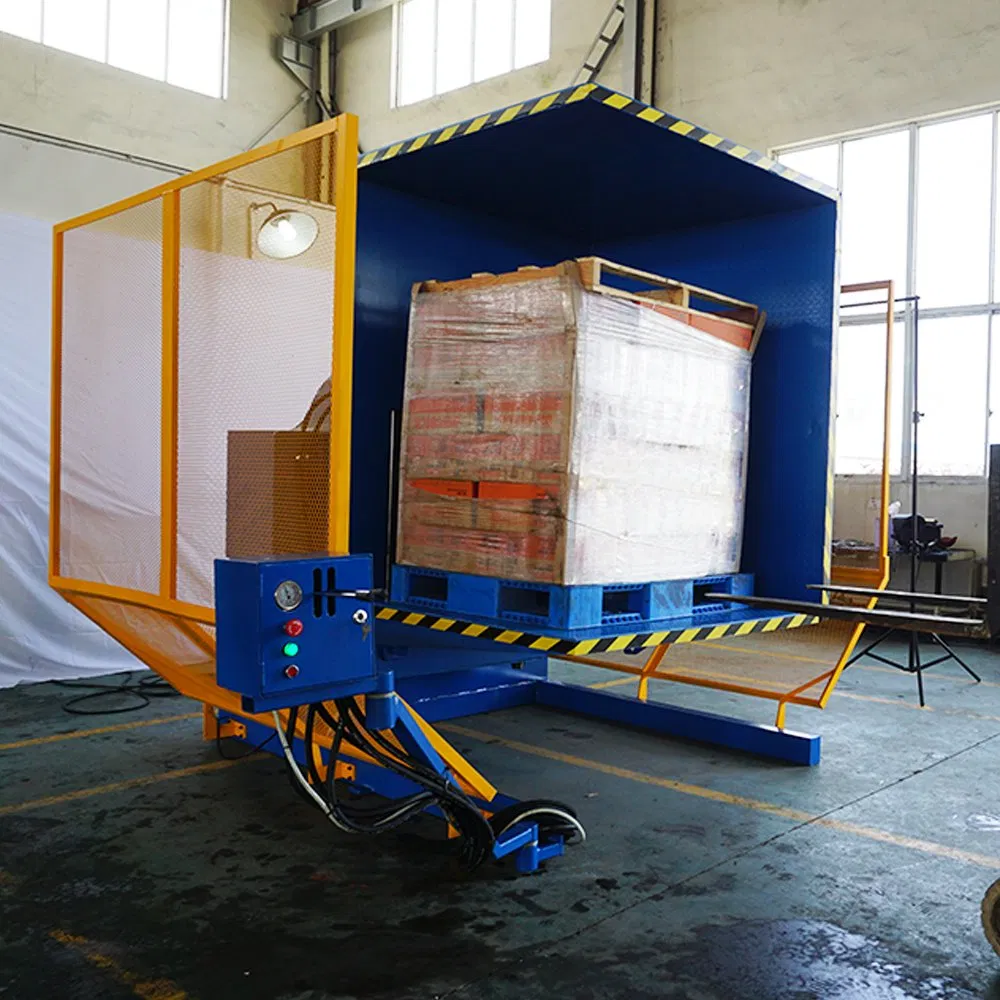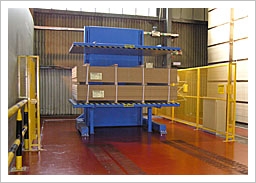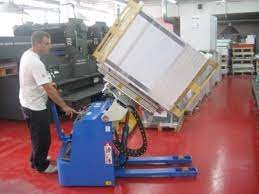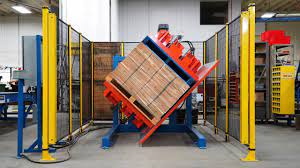Choosing the Right Pallet Inverter for Argentina's Demands to Lower Downtime in Agri-Export Processing Plants
In Argentina's busy agri-export plants, every minute of downtime costs money. You ship products to global markets, and delays can lead to spoiled goods, missed deadlines, and unhappy customers. The pressure is constant. You might be manually transferring sacks of grain or boxes of fruit from production pallets to shipping pallets, a slow and risky process. This manual work often leads to product damage, worker injuries, and bottlenecks that bring your entire line to a halt. You know there must be a better way to handle these transfers, a way that is faster, safer, and more reliable.
The best way to lower downtime in Argentine agri-export processing plants is by choosing a pallet inverter with the right specifications for your products. A pallet inverter, or pallet changer, automates the process of transferring goods from one pallet to another. This machine securely clamps the load, rotates it, and allows for a quick and safe pallet swap. Selecting a model with adjustable clamping pressure for delicate goods, appropriate load capacity, and features for hygiene is key to minimizing damage and maximizing uptime.

I have spent over 25 years in the packaging machine industry, first as an engineer and now as the owner of SHJLPACK. I have seen firsthand how a single piece of equipment can transform an entire operation. The challenges you face in Argentina are familiar to me. I have worked with many clients who struggled with the same bottlenecks. They needed to meet strict export standards, protect their valuable products, and keep their lines moving. This article is not just about a machine; it is about a solution. I will share my knowledge to help you understand how to choose the right pallet inverter for your specific needs, ensuring it becomes a true asset for your business. Let’s dive into the details.
How does a pallet inverter directly impact operational uptime in an agri-export facility?
Your facility is a complex system, and any weak link can cause the entire chain to break. Manual pallet swapping is often that weak link. Workers get tired, they make mistakes, and accidents happen. A dropped pallet of premium fruit can mean thousands of dollars lost in an instant. The process is slow, creating a queue of goods waiting to be processed, which means your production line can't run at full speed. This constant, low-level inefficiency slowly eats away at your profits and your ability to meet shipping schedules. The problem gets worse during peak season when the pressure is highest.
A pallet inverter directly boosts operational uptime by replacing slow, unreliable manual labor with a fast, consistent, and safe automated process. It reduces the time taken to swap a pallet from many minutes to just one or two. This eliminates a major bottleneck in your workflow. The machine's controlled clamping and rotation also dramatically reduce the risk of product damage. This means fewer interruptions for clean-ups and quality control rejections. By making the process predictable and repeatable, you can better schedule your production and shipping, leading to a much smoother and more efficient operation.

Let's break down exactly where a pallet inverter makes a difference. I've seen these machines solve very specific problems for agri-exporters. Think about the entire journey of your product from the field to the container. Any point where a pallet needs to be changed is a potential point of failure and delay.
Eliminating Manual Handling Bottlenecks
Manual pallet exchange is a time-consuming task. It typically involves de-stacking a pallet by hand, box by box or bag by bag, and then re-stacking it onto a new pallet. This isn't just slow; it's a productivity killer. A team of two workers might take 10-20 minutes to transfer a full pallet load. If you process hundreds of pallets a day, the lost time adds up to hours of non-productive labor. A pallet inverter performs this same task in about 60-90 seconds with a single operator. This incredible speed difference removes the bottleneck completely. Your downstream processes, like stretch wrapping and container loading, will no longer be starved for products.
Reducing Product Damage and Waste
In the agri-export business, your product is your reputation. Bruised fruit, torn sacks of grain, or crushed boxes are unacceptable to international buyers. Manual handling is the primary cause of such damage. A tired worker can easily drop a box or mis-stack a pallet. A pallet inverter handles the entire load as a single, stable block. It clamps the product securely from the sides and top before any movement occurs. This gentle but firm handling ensures that even delicate products like avocados or berries are transferred without being crushed or shifted. I recall a client who exported high-value grapes. They were losing almost 7% of their product during the transfer to plastic export pallets. After installing a pallet inverter, that loss dropped to less than 0.5%. The machine paid for itself in less than a year on damage reduction alone.
Improving Worker Safety
Lifting heavy boxes and bags all day leads to back injuries and fatigue. This is a serious issue that affects your workforce's morale and can lead to high insurance costs and lost time due to injuries. A pallet inverter removes the need for this strenuous manual labor. The operator uses simple controls to manage the entire process, standing safely away from the moving load. This creates a safer work environment, which is not only a legal and moral responsibility but also good for business. A healthy, safe team is a productive team.
Here is a simple table to show the direct impact:
| Metric | Manual Pallet Exchange | With Pallet Inverter | Impact on Uptime |
|---|---|---|---|
| Time per Pallet | 10-20 minutes | 1-2 minutes | Massive Increase in throughput |
| Labor Required | 2-3 workers | 1 operator | Significant Reduction in labor cost |
| Product Damage Rate | 3-7% (Varies) | < 1% | Fewer Stops for cleanup and repacking |
| Worker Injury Risk | High (Lifting, Strains) | Very Low | Reduced Lost Time from injuries |
| Process Consistency | Low (Depends on team) | High (Machine-controlled) | Predictable Flow, better planning |
By looking at these numbers, you can see it's not a small improvement. It's a fundamental change in how your facility operates, directly boosting uptime by making your process faster, safer, and much more reliable.
What are the critical specifications to consider for a pallet inverter in Argentina's unique agricultural environment?
You know that a machine that works well in a European electronics warehouse might fail completely in an Argentine fruit packing plant. The environment is different. The products are different. The demands are different. You might be dealing with dust from grains, moisture from washed produce, or the need to use specific food-grade pallets. If you choose a pallet inverter based on a generic catalog without considering these local factors, you are setting yourself up for failure. The machine could corrode, damage your products, or fail to handle your specific pallet types, leading to even more downtime than you had before.
To choose the right pallet inverter for Argentina's agri-export sector, you must focus on three critical specifications: adjustable clamping pressure, material and hygiene standards, and load capacity and stability. Adjustable pressure is vital for protecting delicate produce from being crushed. The machine's construction material, such as stainless steel, is essential for hygiene and resistance to moisture and corrosion. Finally, the capacity must safely handle your heaviest loads, and the design must accommodate the various types of pallets used in your supply chain, from local wooden pallets to plastic export pallets.

Let's go deeper into these specifications. Getting these details right is the difference between buying a tool and buying a solution. As an engineer, I always tell my clients to think about the worst-case scenario. What is the heaviest, most awkward, or most delicate load you need to handle? Design for that, and the machine will serve you well for years.
Adjustable Clamping Pressure Control
This is perhaps the most important feature for any agri-exporter. You handle a variety of products. Sacks of soybeans can handle high pressure, but boxes of fresh peaches cannot. A standard pallet inverter with a single, fixed pressure setting is a huge risk. It will either be too weak to hold heavy loads securely or too strong and crush your delicate goods.
A modern pallet inverter must have a pressure regulation system that is easy to adjust. The operator should be able to set the pressure based on the product being handled. The best systems have multiple pre-set options. For example, you could have a "Grain" setting, a "Boxed Fruit" setting, and a "Bottled Goods" setting. This makes it simple for operators to choose the correct pressure and eliminates guesswork. I have seen systems where a simple mistake in pressure setting led to an entire pallet of wine bottles being shattered. The cost of that single mistake was more than the price difference for a machine with a proper pressure control system.
Material, Finish, and Hygiene Standards
Agri-export facilities are often wet, dusty, and subject to strict hygiene regulations, especially for food products. A pallet inverter made from standard painted steel will not last. The paint will chip, and the metal will rust, creating a hygiene hazard and leading to premature machine failure.
For any application involving food, you must consider:
- Stainless Steel Construction: Key components that touch or are near the product, and often the entire frame, should be made of stainless steel (like SS304). This material is resistant to rust and is easy to clean and sanitize.
- "Wash-down" Rating: The machine, including its electrical components and motors, should be designed to withstand regular high-pressure cleaning. This is often indicated by an IP rating (e.g., IP65 or higher), which shows it is protected against water jets.
- Smooth Design: Look for a machine with minimal crevices, ledges, or sharp corners where water, dust, and bacteria can accumulate. A smooth, sloped design helps with water runoff and makes cleaning much more effective.
Load Capacity, Stability, and Pallet Compatibility
You need to know the maximum weight of your pallets. Don't just think about the average; think about the absolute heaviest pallet you will ever need to process. Always choose a pallet inverter with a capacity at least 20-25% higher than your maximum load. This safety margin ensures the machine is not under constant strain, which extends the life of its hydraulic and structural components.
Stability is also key. The machine's base must be wide and heavy enough to remain stable while rotating a heavy, off-center load. But stability is not just about the machine itself. It is also about how it handles your pallets. Argentina uses different pallet types, including standard AR-1 pallets (1000mm x 1200mm), as well as CHEP pallets and various plastic export pallets. The inverter's loading platform and clamping mechanism must be able to accommodate these different sizes and designs securely. A machine that can only handle one specific pallet size will limit your operational flexibility.
Here's a comparison of inverter types for agri-export:
| Feature | 180° Inverter (Clamps and Rotates) | 90° Tipper (Pushes load) | Recommendation for Agri-Export |
|---|---|---|---|
| Product Handling | Very Gentle. Load is held secure. | Can cause shifting or sliding. | 180° Inverter is much better for fragile or unstable goods. |
| Speed | Fast (60-90 seconds) | Slower (requires more steps) | 180° Inverter for higher throughput. |
| Hygiene | Can be built in full stainless steel. | More moving parts can be harder to clean. | 180° Inverter is easier to make fully wash-down compliant. |
| Flexibility | Handles a wide range of load types. | Best for solid, stable loads like blocks. | 180° Inverter is more versatile for varied agri-products. |
For the vast majority of agri-export applications in Argentina, a 180° inverter with the specifications we discussed is the superior choice. It provides the gentle handling, hygiene, and flexibility you need.
How can we calculate the ROI of a pallet inverter to justify the investment?
As a business owner, you don't invest in equipment; you invest in results. A pallet inverter is a significant capital expense, and you need to be certain it will deliver a positive return on investment (ROI). Just hearing that it will "improve efficiency" is not enough. You need to see the numbers. You have to justify this cost to yourself, your partners, or your board. If you can't build a clear, conservative financial case for the machine, then it's not the right time to buy it. The fear is spending a lot of money on a machine that sits in the corner because it didn't deliver the promised savings.
You can justify the investment in a pallet inverter by calculating its ROI based on concrete savings in three areas: labor costs, reduction in product damage, and pallet management costs. First, calculate the annual cost of the workers currently doing manual transfers. Second, estimate the annual cost of products damaged during this process. Third, account for savings from being able to use cheaper internal pallets and switching to required export pallets only at the final stage. By adding these annual savings together and dividing them by the total cost of the pallet inverter, you can determine the payback period.

Let's build a practical framework for this calculation. I've walked through this process with dozens of factory owners. The key is to be realistic with your numbers. It's always better to underestimate the savings and be pleasantly surprised than the other way around.
Step 1: Quantifying Your Annual Labor Savings
This is the most straightforward part of the calculation.
- Workers per shift: How many employees are dedicated to manually transferring pallets? Let's say it's 2 workers.
- Shifts per day: How many shifts do you run? Let's say 2 shifts.
- Total workers: 2 workers/shift * 2 shifts = 4 workers' time is dedicated to this task.
- Annual Labor Cost: What is the fully-loaded annual cost of an employee (salary, benefits, taxes)? Let's use a hypothetical number of $15,000 USD per year.
- Total Manual Labor Cost: 4 * $15,000 = $60,000 per year.
A pallet inverter requires one operator. This person can often manage the inverter while also performing another task, like driving a forklift. For this calculation, let's assume you need 1 dedicated operator across 2 shifts, so 2 workers total.
- Inverter Labor Cost: 2 * $15,000 = $30,000 per year.
- Annual Labor Savings: $60,000 - $30,000 = $30,000 USD.
Step 2: Calculating Savings from Reduced Product Damage
This requires some honest assessment.
- Value of an average pallet: What is the sale value of the goods on one pallet? Let's say $2,000.
- Pallets per day: How many pallets do you transfer daily? Let's say 100.
- Current damage rate: What percentage of pallets have some damage during manual transfer? Be conservative. Let's say 3% of pallets have damage, and on those, the average loss is 25% of the pallet's value.
- Daily Loss: 100 pallets 3% $2,000/pallet * 25% loss = $150 per day.
- Annual Loss (Manual): $150/day * 250 working days = $37,500 USD.
With a pallet inverter, the damage rate drops dramatically. Let's assume it falls to 0.2%.
- Annual Loss (Inverter): 100 pallets/day 0.2% $2,000/pallet 25% loss 250 days = $2,500 USD.
- Annual Damage Savings: $37,500 - $2,500 = $35,000 USD.
Step 3: Adding Pallet Management Savings and Calculating ROI
This is an often-overlooked saving. You can use cheaper, less durable wooden pallets for internal use and switch to expensive, treated, or plastic export pallets only at the final shipping stage.
- Cost of export pallet vs. internal pallet: Let's say an export pallet costs $25 and an internal pallet costs $10. The difference is $15.
- Annual Pallet Savings: 100 pallets/day $15/pallet 250 days = $375,000 USD.
This number can be huge! For this example, let's assume you're already using export pallets internally, so this is a new saving. In many cases, companies can recover pallets, so let's be very conservative and say the net saving is only 10% of this, or $37,500 USD.
Now, let's put it all together.
| Savings Category | Annual Savings (USD) |
|---|---|
| Labor Savings | $30,000 |
| Product Damage Reduction | $35,000 |
| Pallet Management Savings | $37,500 |
| Total Annual Savings | $102,500 |
Now, for the final step. Let's say the total cost to purchase, ship, and install a suitable pallet inverter is $70,000 USD.
Payback Period = Total Investment / Total Annual Savings
Payback Period = $70,000 / $102,500 = 0.68 years, or about 8 months.
A payback period of under one year for a major piece of industrial equipment is an excellent investment. When you present this kind of clear, conservative calculation, the decision becomes logical and easy to defend.
What level of automation is right for my plant, and what are the integration challenges?
Thinking about automation can be overwhelming. You see videos of fully robotic warehouses and wonder if you need to go all-in. The sales pitches promise a future with no human workers, but your reality is an existing factory with an experienced workforce and a limited budget. You worry about the complexity. Will this new machine integrate with your current systems? Who will operate it? What happens when it needs maintenance? Choosing the wrong level of automation can be just as bad as having none at all. You could end up with a system that is too complex for your team or too simple to solve your core problem.
The right level of automation depends on your specific throughput, existing infrastructure, and workforce skills. You don't have to jump to a fully automated line. You can start with a standalone pallet inverter, which offers huge benefits with minimal integration. For higher volume operations, a semi-automated system with conveyors can be added. Full automation is only necessary for very high-speed, 24/7 facilities. The key is to match the technology to your real-world needs and plan for a phased approach to integration.

In my journey from engineer to factory owner, I learned that the best technology is the technology that gets used effectively. A simple, reliable machine running every day is better than a complex, advanced one that is always down. Let's look at the different levels of automation and what they mean for your plant.
Level 1: Standalone Machine
This is the most common and often the most practical starting point.
- What it is: A single pallet inverter unit. A forklift driver brings a pallet to the machine, the operator performs the inversion, and the forklift takes the new pallet away.
- Best for: Facilities processing up to 20-30 pallets per hour. It’s perfect for replacing a manual transfer station without changing the rest of your workflow.
- Integration Challenges: Very few. The main requirement is space and a power supply. You don't need to connect it to any other software or machinery. The biggest challenge is simply training your forklift drivers and the machine operator on the new, simple workflow.
- My Experience: This is the entry point for 90% of the clients I've worked with. It solves the core problem—slow, unsafe manual transfers—with the lowest possible investment and disruption. It delivers a fast ROI and builds confidence in automation technology.
Level 2: Semi-Automated System
This is the next logical step up.
- What it is: A pallet inverter connected to infeed and outfeed roller conveyors. A forklift can drop a pallet on the infeed conveyor and immediately go do another task. The pallet moves into the inverter automatically, is processed, and then moves to the outfeed conveyor to be picked up.
- Best for: Higher volume facilities processing 30-50 pallets per hour. It decouples the forklift's work from the inverter's cycle time, creating a more efficient, continuous flow.
- Integration Challenges: This requires more planning. You need to integrate the conveyors with the inverter's control system. This is usually handled by the machine supplier. You also need to consider the physical layout of your floor space to accommodate the conveyors. You are not yet integrating with your plant's main software, but you are creating a small, automated island.
Level 3: Fully Integrated Line
This is the top tier of automation.
- What it is: The pallet inverter and its conveyors are fully integrated into your plant's main production line and controlled by your Warehouse Management System (WMS) or Manufacturing Execution System (MES). The entire process, from production to pallet wrapping to pallet inversion, is automated.
- Best for: Very large, high-speed facilities running 24/7 with a strong focus on data and minimal human intervention.
- Integration Challenges: This is a major project. It requires close collaboration between the machine supplier and your IT/engineering team. The inverter needs to "talk" to your MES/WMS, receiving commands and sending back data on each pallet. This requires software and network integration. While it offers the highest level of efficiency, it also comes with the highest cost and complexity.
| Automation Level | Throughput (Pallets/Hour) | Integration Complexity | Best For |
|---|---|---|---|
| Standalone | < 30 | Low (Power and space) | Replacing a manual station with minimal disruption. |
| Semi-Automated | 30 - 50 | Medium (Conveyors, local controls) | Improving flow and forklift efficiency in busy plants. |
| Fully Integrated | > 50 | High (MES/WMS software, network) | Large, 24/7 operations seeking total process control. |
My advice is always to start with the simplest solution that meets your immediate goals. For most agri-export plants in Argentina looking to solve a downtime problem, a standalone or semi-automated system is the sweet spot. It delivers 80% of the benefits of full automation for 20% of the complexity and cost.
Conclusion
Choosing the right pallet inverter is a strategic decision. It directly lowers downtime, protects your product, and improves safety. By focusing on your specific needs, you find a powerful solution.


